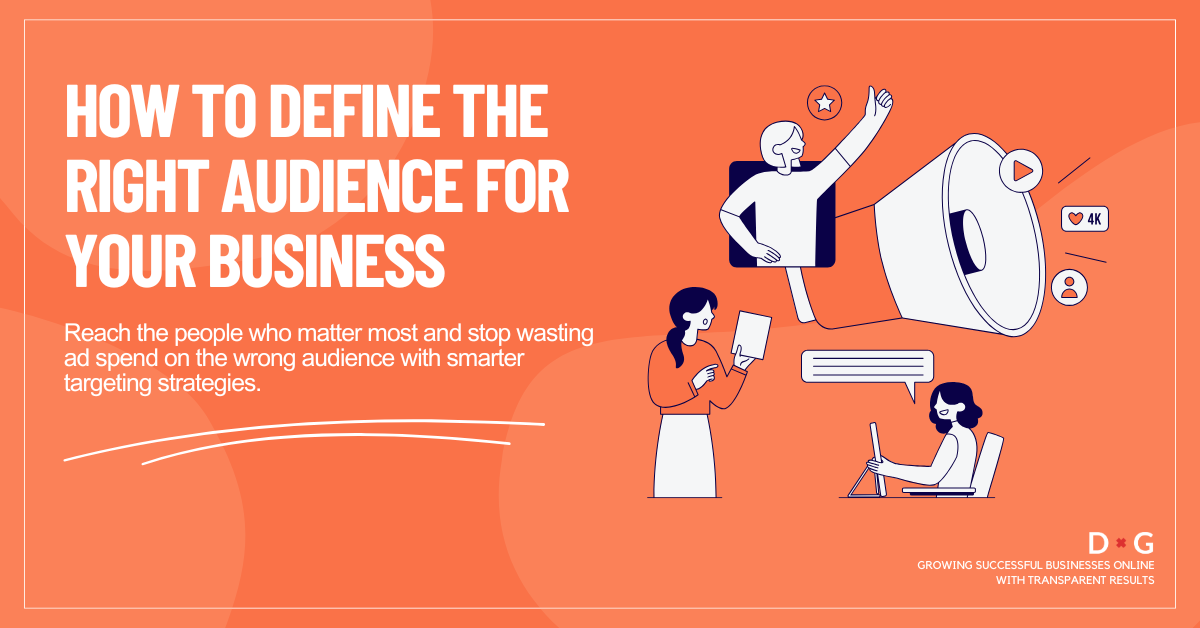
Are your ads not getting clicks, or worse, not bringing in the right customers? So, how do you define the right audience for your business
You’re not alone. Many new business owners think the problem is the ad copy or the budget. But often, the real issue is much simpler: they’re targeting the wrong audience.
If you’re ready to launch your first PPC campaign, or you’re wondering why past ones didn’t work, this guide is for you.
In this post, we’ll show you how to define the right audience for your business so you can stop wasting your marketing dollars and start attracting real customers.
Why Audience Targeting Is Vital for PPC Advertising
Whether you’re running ads on Google or social media, pay-per-click (PPC) advertising can be one of the fastest ways to reach new customers. But only if the right people see those ads.
Without the right audience:
- You get lots of clicks, but no conversions
- Your ads appear to people who aren’t interested
- You pay more for fewer results
So how do you find that ideal audience?
Let’s break it down step-by-step.
Step 1: Understand What You’re Selling
Before you can determine who you’re selling to, you need to be crystal clear about what you’re offering.
Ask yourself:
- What problem does my product or service solve?
- Is my offer unique?
- What benefits do customers care about most?
Example:
If you’re a bookkeeping service for tradies in Brisbane, you’re not just offering “financial help”, you’re offering peace of mind, saved time, and less tax stress.
Knowing your true value helps you match it with people who need it most.
Step 2: Identify Demographics and Psychographics
What are Demographics and Psychographics in PPC Advertising?
These form the foundation of effective audience targeting.
Demographics:
- Age
- Gender
- Income
- Job title
- Location
- Education
Psychographics:
- Lifestyle
- Interests
- Values
- Shopping habits
- Hobbies
Understanding both helps you narrow down your perfect customer and avoid wasting money on the wrong clicks.
Step 3: Create a Customer Persona
Think of a customer persona as a sample customer who represents your main audience..
Example Customer Persona:
-
- Name: Kylie
- Age: 34
- Location: Melbourne
- Job: Owner of a boutique fitness studio
- Pain Point: Struggles with getting new clients online
- Goal: Wants to run ads that bring in paying customers
When your ad talks directly to “Kylie”, it feels more personal and that means more clicks and conversions.
Step 4: Use Real Data to Refine Your Audience
Make informed choices by validating your assumptions with data.
Tools to Use:
- Google Analytics: See who’s visiting your website
- Google Ads Audience Insights: Understand audience behaviours
- SEMrush or Ahrefs: Find keyword search trends in the location you are targeting
Using data ensures your PPC advertising is aimed at the people most likely to convert.
Step 5: Test and Tweak Your Targeting
Even after building your audience profile, you’ll still need to test.
Try:
- A/B testing different audience groups
- Running ads with different locations or interests
- Comparing desktop vs mobile users
Each PPC platform gives you detailed reports; understand the data and tweak your audience settings over time.
Pro Tip: What works in Sydney might not work in Perth. Keep your targeting local when possible, especially for local businesses.
Common Mistakes to Avoid in Audience Targeting
- Targeting everyone
- Using outdated or random interests
- Fail to tailor your messaging to the people you’re trying to reach.
- Not reviewing campaign data regularly
Note: Targeting a broad audience can drive up your ad costs and lower your return.
Final Checklist Before Running PPC Advertising
- Have you clearly defined your product or service?
- Do you know who your ideal customer is?
- Have you considered both demographics and psychographics?
- Have you used tools to confirm your assumptions?
- Are you prepared to test and tweak over time?
If you answered yes, you’re ready to launch smarter, more cost-effective ads.
Conclusion:
Defining your audience isn’t just a marketing buzzword; it’s the first and most important step before running any ad campaign. Whether you’re using Google Ads or social media platforms, the key to success is knowing exactly who you want to reach.
Before spending a cent on PPC advertising, spend time understanding your audience. The results will speak for themselves.
